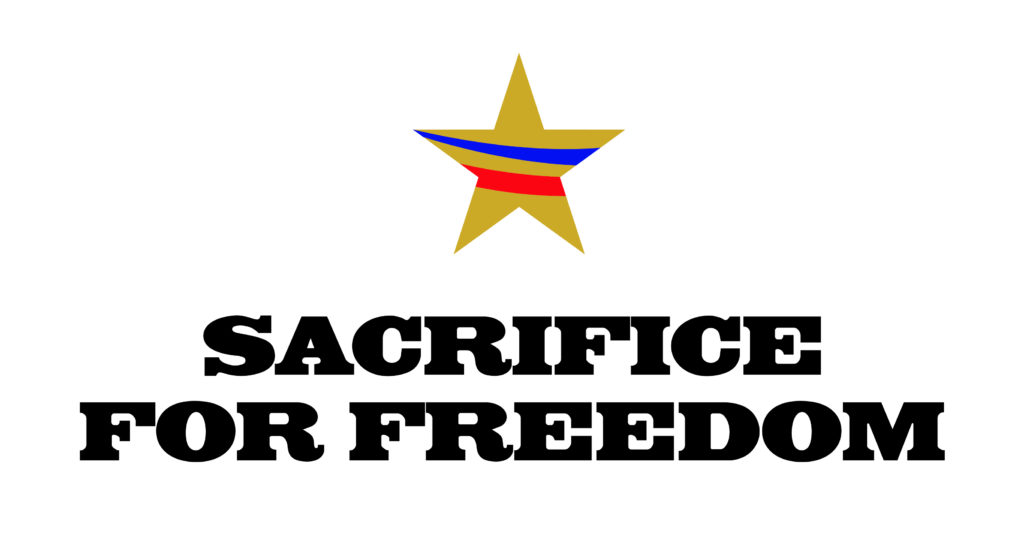Private First Class George Texeira
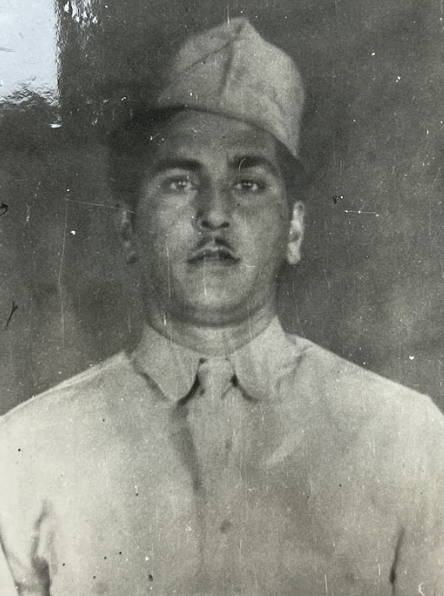
- Unit: 27th Infantry Division, 105th Infantry Regiment, Company K
- Service Number: 30107409
- Date of Birth: January 8, 1922
- Entered the Military: July 26, 1943
- Date of Death: July 7, 1944
- Hometown: Lahaina, Maui, Hawaiʻi
- Place of Death: Saipan, Northern Mariana Islands
- Award(s): Purple Heart
Mentored by Mr. Micah Benavitz
Mililani High School
2022/2023
Early Life
George Texeira was born in Lahaina, Maui, Hawaiʻi, to John and Mae Texeira on January 8, 1922. He was a brother to Irene, Gladys, Stanley, Henrietta, Gordon, and Winona Texeira. In addition, he was a half-brother to Joseph, Belinda, Florence, Joe, Josephine, August, John, Violet, Nancy, Patrick, and Gilbert Texeira. George Texeira’s father, John Texeira, was a Fire Engineer. It is unknown if his mother, Mae Texeira had an occupation.
Young Life
George Texeira attended Waihee Elementary School and Iao Intermediate in Maui. His graduation year is unknown. As did many young men during the Great Depression, he worked for the Civilian Conservation Corps, whose goal was to improve America’s public lands, forests, and parks. Following his time with the Civilian Conservation Corps George left his home island for Honolulu, Oahu. While on Oahu, he worked as a truck loader for Armour & Co. Honolulu.
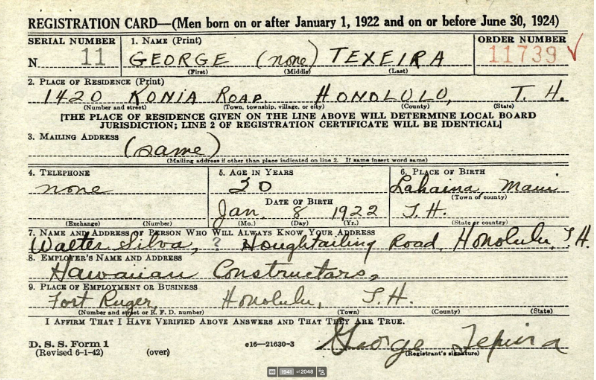
Homefront
Lahaina, Maui
Lahaina was once known as Lele, which in English means “relentless sun.” Once the capital of the Hawaiian Kingdom, it would later be replaced by Honolulu, Oahu. Despite being intended only for native Hawaiians, Lahaina became a populous town due to foreign land acquisition. The community of Lahaina was involved in food production and services such as the pineapple and sugar industries.
Military ‘Take Over’
Many of the Hawaiian Islands during World War II became major training, staging, and supply bases for the religion, especially Maui. Maui contained about 55 training areas ranging from combat shooting games ranges to a bazooka area.
During World War II, especially after the attack on Pearl Harbor, much changed in the lives of Hawaiʻi’s civilians. Many of the beaches became lined with barbed wire. Gas masks and blackouts were adopted, and martial law was activated in Hawaiʻi.
Due to martial law, the government took away many of the peoples’ rights. Many schools were seized with little to no warning by the military. In addition, many civilians had to give the sugar and pineapple plantations, equipment, and workforce to the military. The courts became filled with military judges who with more power than civilian judges. Military judges could arrest someone and hold them indefinitely without bail or informing the person of the charges against them.
Military Experience
Registration and Enlistment
Private First Class Texeira registered for military service on June 30, 1942, and officially enlisted on July 26, 1943, at 21. After his enlistment, he first trained at Schofield Barracks. Then he served with the 27th Infantry Division as a Private First Class for the Makin Island Attack and Operation Forager (Battle of Saipan). Private First Class Texeira never received a promotion. He was killed in action at the rank of a Private First Class.
27th Infantry Division
The 27th Infantry Division was reactivated on October 15, 1940, and was overseas starting March 10, 1942. The 27th Infantry Division was one of the first to arrive in Hawaiʻi after the attack on Pearl Harbor. Its primary role in Hawaiʻi was to defend outer islands from amphibious attacks and various campaigns in the Pacific. Private First Class Texeira was with the division for much of their participation in the Pacific, including the Raid on Makin Island and Operation Forager.
Training
Private First Class Texeria received intense training targets on weapons qualification designed for personnel and their assigned weapon in addition to familiarization with all weapons, swimming 50 yards with various situations, a one-mile run each day, bayonet training, and hand-to-hand combat. Soldiers also participated in more specific training focused their job and position. While this training was helpful for any attack or assault he would participate in, it was targeted for Operation Forager.
Raid on Makin
The Raid on Makin Island was the first seizure on any atoll by an Army Landing Force. The plan the 27th Infantry Division had formed was simple and concise but not technically easy. It would begin with the U.S. Navy preparing the island with high-intensity gunfire support and later air protection for the movement to shore.
The 165th Regiment Combat Team (RCT) would land on Beach Red 2 and Beach Red, advance to the divided headline, and continue south. Special detachments then moved inland while fighting against sniper fire. The raid aimed to destroy the Imperial Japanese installations, take prisoners, and interfere with Japanese attention and reinforcement from Allied landings on Guadalcanal and Tulagai.
The 27th Infantry Division lost 66 soldiers, and 152 soldiers were injured. In contrast, Japan lost 550 men, and 105 men became Prisoners of War. The remaining troops were ready to sail, but because of a report of close Japanese aircraft, the convoy was sent to the shores of Oahu.
Operation Forager (Saipan)
Operation Forager wanted to capture the Central Pacific Islands of Mariana and Palau in Micronesia from Japan. This gave the U.S. military range for a B-29 long-range bomber to strike Japan. A B-29 long-range bomber was used to drop the nuclear bombs in Japan. The fighting in Saipan by the 27th Infantry Division was broken up into four distinctive phases.
The operation started with a series of smaller landings to gain control of Aslito Airfield and then clear Nafutanb point, which was filled by the attack on Death Valley and Purple Heart Ridge. Later attacks targeted Paradise Valley and Tanagpag Plain. Finally, the four different phases ended with cleaning up what had happened after the resistance on Saipan was controlled and terminated.
The fighting on Saipan was brutal and defeated the Japanese 43rd Infantry Division. There were a multitude of lessons learned from the invasion of Saipan. Technical and tactical mistakes were taken into account by the U.S. Army.
Private First Class George Texiera was killed in action on Saipan on July 7, 1944. The 27th Infantry Division faced the largest Banzai attack during World War II while on Saipan with around 4,000 Japanese troops killed and around 1,000 American troops killed or injured. Banzai was one of many strategies that the Imperial Japanese military used. The soldiers would yell Banzai as massive human waves of Japanese soldiers attacked the enemy position.
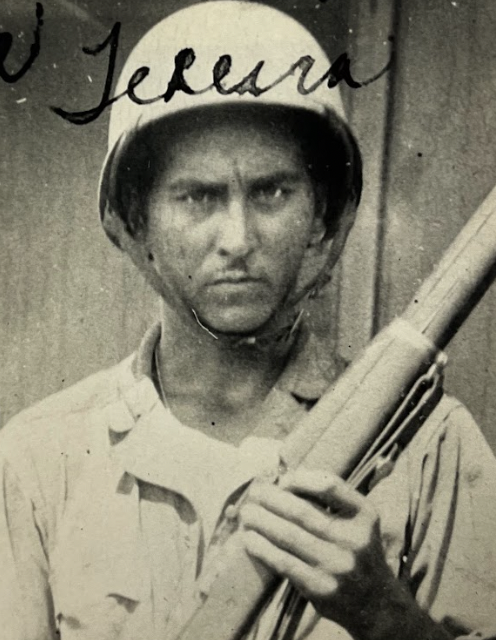
Eulogy
Private First Class George Texiera was killed in action on Saipan on July 7, 1944. The 27th Infantry Division faced the largest Banzai attack during World War Two while on Saipan with around 4,000 Japanese troops killed and around 1,000 American troops killed or injured. Banzai was one of many strategies that the Imperial Japanese military used. The soldiers would yell Banzai as massive human waves of Japanese soldiers attacked the enemy position.
Private First Class George Texiera was first laid to rest in the 27th Infantry Division Cemetery, Mariana Islands. As per his family’s wishes, his body was returned to Hawaii to be buried at the National Memorial Cemetery of the Pacific on August 5, 1949. At his death, Texeira did not leave a will only possessions found on his body included a cigarette case, a pen, a map-carrying case, and a charm.
Private First Class George Texiera was one of the many brave men and women of World War II who answered the call to defend their country and the citizens they had never met. He displayed selfless bravery and heroism by giving the ultimate sacrifice: his life. Private First Class Texeira defended and protected the freedoms and ideals that we, unlike many countries, are able to enjoy.
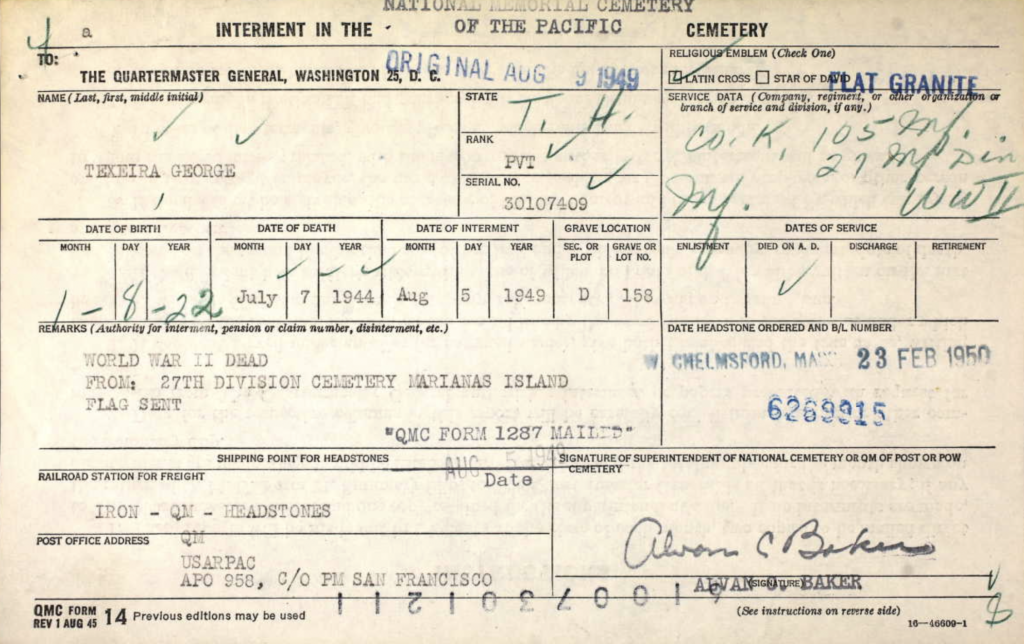
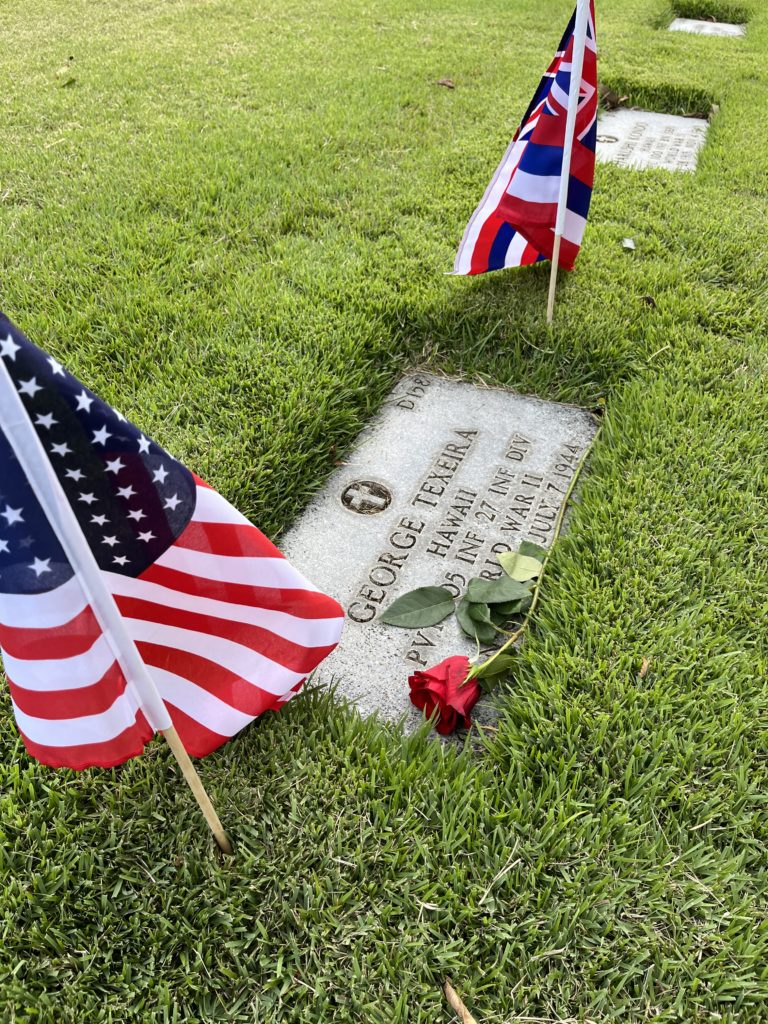
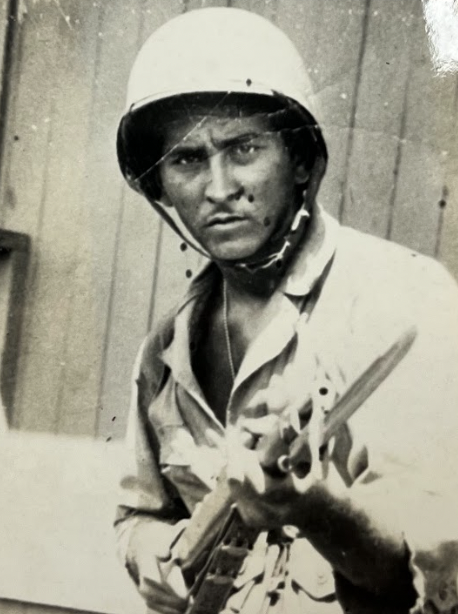
Reflection
What I have taken away from this program is a much deeper respect and gratitude for all the men and women who have fought to preserve the freedoms we enjoy in this country. Through the live program, I learned many stories of Silent Heroes, including Private First Class George Texeira. Then stepped back and truly realized the sacrifice it is to have freedom.
Having the ability to visit the memorials of those Silent Heroes was truly a humbling experience. I was able to make Private First Class George Texeira’s story known. The meaningful experiences I have gone through during the Sacrifice for Freedom®: World War II in the Pacific Student and Teacher Institute will be ones that will stay with me for the remainder of my life.
Bibliography
Primary Sources
“Fleet Requires Vast Quantiies of Food.” Honolulu Star-Bulletin [Honolulu, Hawaii], April 9, 1938. Newspapers.com (274990881).
George Texeira. Hawaii, U.S., Births, Marriages, and Death Cards, 1850-1950. Digital image. https://www.ancestry.com.
George Texiera. Honolulu Hawaii, U.S., National Memorial Cemetery of the Pacific (Punchbowl), 1941-2011. Digital image. https://www.ancestry.com.
George Texeira, Individual Deceased Personnel File, Department of the Army.
George Texeira, Transcript Sheet for Casualty Questionnaire, Hawaii War Records Depository.
George Texeira. U.S., National Cemetery Interment Control Forms, 1928-1962. Digital images. https://www.ancestry.com.
George Texeira. World War II Army Enlistment Records, 1938-1946. https://www.ancestry.com.
George Texeira. World War II Draft Cards Young Men, 1940-1947. Digital images. https://www.ancestry.com.
Hawaii. Maui. 1930 U.S. Census. Digital images. https://www.ancestry.com.
Hawaii. Maui. 1940 U.S. Census. Digital images. https://www.ancestry.com.
Hawaii. Maui. 1950 U.S. Census. Digital images. https://www.ancestry.com.
John Rodrigues Texeira. Hawaii, U.S., Birth Certificates and Indexes, 1841 – 1944. https://www.ancestry.com.
“List of Valley Isle Soldiers Killed In War Now Totals 44.” The Honolulu Advertiser [Honolulu, Hawaii], August 5, 1944. Newspapers.com (119856947).
“Pvt. Texeira of Maui Is Killed In Action.” Honolulu Star-Bulletin [Honolulu, Hawaii], July 31, 1944. Newspapers.com (275459667).
Texeira, Prvt. George (Army). University of Hawaii, Hawaii War Records Depository, Honolulu.
Secondary Sources
27th Infantry Division. U.S. Army Center for Military History. Last modified January 31, 2021. Accessed May 19, 2023. https://history.army.mil/html/forcestruc/cbtchron/cc/027id.htm.
Allmon, William B. “Target: Makin Island.” World War II Magazine, August 16, 2019. https://www.navytimes.com/news/your-navy/2019/08/16/target-makin-island/.
Bartholomew, Gail. Maui Remembers A Local History. Honolulu, Hawai’i: Mutual Publishing, 1995.
Brown, DeSoto and Ann Ellett. Hawaii Goes to War: Life in Hawaii from Pearl Harbor to Peace. Editions Limited, 2001.
Chris Hart and Partners. Maui Island History: Lessons From the Past—A Guide to the Future. September 2006. Accessed March 29, 2023. https://www.mauicounty.gov/DocumentCenter/View/10483/GP-2030-Maui-Island-History-Report.
George Texeira, Texeira Family Tree. Accessed February 24, 2023. https://www.ancestry.com.
“The History of Maui during the War Years.” National Marine Sanctuaries. Accessed March 28, 2023. http://sanctuaries.noaa.gov/maritime/expeditions/maui/history.html.
“John William Stanley Texeira Sr.” Find A Grave. Updated October 29, 2016. Accessed March 3, 2023. https://www.findagrave.com/memorial/171973695/john-william_stanley-Texeira.
Kaune, Charles S. “The National Guard In War: An Historical Analysis Of The 27th Infantry Division (New York National Guard) In World War II.” New York State Military Museum and Veterans Research Center. Accessed May 17, 2023. https://museum.dmna.ny.gov/unit-history/conflict/world-war-2-1939-1945/27th-infantry-division-world-war-two/national-guard-war-historical-analysis-27th-infantry-division-new-york-national-guard-world-war-ii/national-guard-war-historical-analysis-27th-infantry-division-new-york-national-guard-world-war-ii-chapter-four-makin.
Laurie, Clayton D. Anzio. U.S. Army Center for Military History. Last modified January 21, 2010. Accessed February 22, 2023. http://www.history.army.mil/brochures/anzio/72-19.htm.
“A Little History Lesson . . . Lahaina! . . . Come and See for Yourself . . .” Hawaii Hideaways Blog. Accessed March 30,2023. https://hawaiihideaways.com/2010/07/a-little-history-lesson-lahaina-come-and-see-for-yourself/.
“Memories of the Home Front.” National Marine Sanctuaries. Accessed March 28, 2023. https://sanctuaries.noaa.gov/maritime/expeditions/maui/homefront.html.
“Pvt George Texeira.” Find A Grave. Updated April 1, 2012. Accessed March 3, 2023. https://www.findagrave.com/memorial/87800076/george-texeira.
Vergun, David. “WWII Operation Forager Provided Key Warfighting Lessons.” U.S. Department of Defense. Updated September 15, 2019. Accessed August 22, 2012. https://www.defense.gov/News/Feature-Stories/story/Article/1947561/wwii-operation-forager-provided-key-warfighting-lessons/#:~:text=All%20U.S.%20services2C%20including%20the,within%20striking%20distance%20of%20Japan.
“Winifred Irene Texeira Gomes.” Find A Grave. Updated May 18, 2013. Accessed March 3, 2023. https://www.findagrave.com/memorial/110751801/winifred-irene-gomes.
